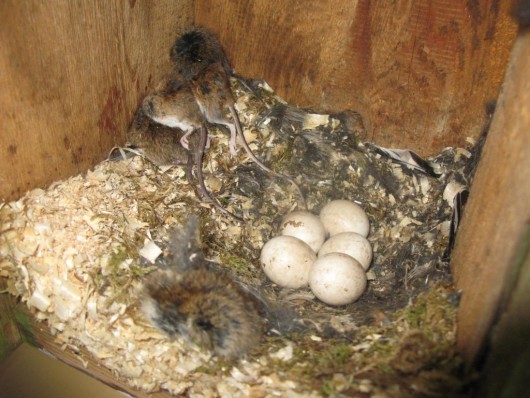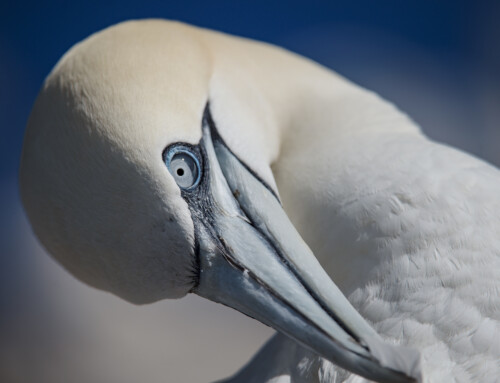Pine Martens temporarily switch to Tengmalm’s Owl eggs instead of small mammals when food is scarce
LINKED PAPER
Indirect food web interactions affect predation of Tengmalm’s Owls Aegolius funereus nests by Pine Martens Martes martes according to the alternative prey hypothesis. Zárybnická, M., Riegert, J. & Kouba, M. 2015. IBIS 157: 459–467. DOI: 10.1111/ibi.12265
The main diet of both Pine Marten and Tengmalm’s Owl in Central Europe comprises small mammals such as Microtus and Myodes voles, and Apodemus mice. Can the indirect food web interactions between these two predators result in Pine Martens preying on Tengmalm’s owl nests during periods of food scarcity?
In boreal and arctic areas, annual variation in breeding success of ground nesting birds depends on cyclical changes in the abundance of small mammals (e.g. Bêty et al., 2001, Ackerman, 2002). When small mammals are abundant, the majority of vertebrate predators feed primarily on those. But when small mammal populations decline, these same vertebrate predators must switch to alternative prey, which often includes the eggs and young of birds. This is called the alternative prey hypothesis (Lack, 1954) and it means that alternative prey species suffer higher predation during the decline and low phase of the rodent cycle. To date, no long-term study has shown such indirect food web interactions in temperate areas. Moreover, such interactions have never been documented between two predators feeding on the same resource.
Tengmalm’s (or Boreal) Owl Aegolius funereus and Pine Marten Martes martes are nocturnal predators, feeding primarily on Microtus and Myodes voles, and Apodemus mice (Korpimäki, 1988, Sidorovich et al., 2005, Zárybnická et al., 2013). When food is scarce, Tengmalm’s Owls shift to alternative prey such Sorex shrews and birds, while martens take small birds, their eggs and nestlings, fruit, beetles and ungulate carcasses (e.g. Sidorovich et al., 2005, Korpimäki and Hakkarainen, 2012). In both Central and Northern Europe, the only documented mammalian predators of Tengmalm’s Owl nests, which are located in natural cavities or nestboxes, are martens (Korpimäki and Hakkarainen, 2012, Figure 1). The proportion of Tengmalm’s Owl nests predated by martens varies between from 5% to 59% and it does not seem to differ between natural cavities and artificial nestboxes (López et al., 2010).

In this study, we analysed a 14-year dataset on predation of Tengmalm’s Owl nests by Pine Martens in Central Europe (the Czech Republic), in relation to the availability of small mammals and Tengmalm’s Owl nests. We found that the probability of nest predation was significantly affected by small mammal availability, as predicted by the alternative prey hypothesis. However, the switch, or functional response, towards Tengmalm’s Owl nests occurred only when Apodemus mice were scarce, and especially when their abundance dropped below 1 prey per 100 trap nights (Figure 2).


As Pine Martens are opportunistic predators, the number of nests predated increased with the number of nests available in the same year (Figure 3). However, we did not find a relationship between the frequency of nest predation and Tengmalm’s Owl breeding frequency (the number of nesting attempts per nestbox available), suggesting that Pine Martens foraged for owl nests at random. Pine Martens preyed upon nests with eggs (Figure 4) more frequently than nests with chicks, indicating that owl nests are usually detected by martens early after egg laying.

Our results show that Pine Martens use nests of Tengmalm’s Owl as an alternative food resource when small mammals are scarce, even in Central Europe where rodent population cycles are not as marked or as regular compared to Northern Europe (Hansson and Henttonen, 1985, Korpimäki et al., 2005). However, the functional response of Pine Martens to Tengmalm’s Owl nests was found only during periods of Apodemus mice scarcity and was not related to the abundance of Microtus and Myodes voles. This suggests that indirect food web interactions can be less pronounced in temperate areas compared to arctic and boreal areas, as rodent populations are stable and prey diversity is higher at lower latitudes (see Zárybnická et al. 2015). Our results document for the first time that switching behaviour in a mammalian predator can influence the breeding success of avian predator feeding on the same prey.
References
Ackerman, J. T. 2002. Of Mice and Mallards: positive indirect effects of coexisting prey on waterfowl nest success. Oikos 99: 469–480. View.
Bêty, J., Gauthier, G., Giroux, J. F. & Korpimäki, E. 2001. Are Goose nesting success and Lemming cycles linked? Interplay between nest density and predators. Oikos 93: 388–400. View.
Hansson, L. & Henttonen, H. 1985. Gradients in density variations of small rodents: the importance of latitude and snow cover. Oecologia 67: 394–402. View.
Korpimäki, E. 1988. Diet of breeding Tengmalm’s Owls Aegolius funereus: long-term changes and year-to-year variation under cyclic food conditions. Ornis Fenn. 65: 21–30. View.
Korpimäki, E. & Hakkarainen, H. 2012. The Boreal Owl: ecology, behaviour and conservation of a forest-dwelling predator. Cambridge: Cambridge University Press. View.
Korpimäki, E., Oksanen, L., Oksanen, T., Klemola, T., Norrdahl, K. & Banks, P. B. 2005. Vole cycles and predation in temperate and boreal zones of Europe. J. Anim. Ecol. 74: 1150–1159. View.
Lack, D. 1954. The natural regulation of animal numbers. Oxford: Oxford University Press. View.
López, B. C., Potrony, D., López, A., Badosa, E., Bonada, A. & Saló, R. 2010. Nest-box use by Boreal Owls (Aegolius funereus) in the Pyrenees Mountains in Spain. J. Raptor Res. 44: 40–49. View.
Sidorovich, V. E., Krasko, D. A. & Dyman, A. A. 2005. Landscape-related differences in diet, food supply and distribution pattern of the Pine Marten, Martes martes in the transitional mixed forest of northern Belarus. Folia Zool. 54: 39–52. View.
Zárybnická, M., Riegert, J. & Šťastný, K. 2013. The role of Apodemus mice and Microtus voles in the diet of the Tengmalm’s owl in Central Europe. Popul. Ecol. 55: 353-361. View.
If you want to write about your research in #theBOUblog, then please see here.





